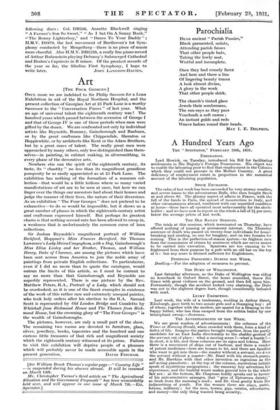Art
[THE FOUR GEORGES.] ONCE more we are indebted to Sir Philip Sassoon for a Loan Exhibition in aid of the Royal Northern Hospital, and the present collection of Georgian Art at 25 Park Lane is a worthy successor to the "Conversation Pieces" of last year. What an age of universal talent the eighteenth century was! The hundred years which passed between the accession of George I and that of George IV is one of those periods when men were gifted by the dozen. We are confronted not only by individual artists like Reynolds, Romney, Gainsborough and Raeburn, or by the great craftsmen like Chippendale, Sheraton or
Hepplewhite, or by architects like Kent or the Adam Brothers, but by a great mass of talent. The really great men were approached by many others, only less distinguished than them- selves—in painting, in cabinet making, in silversmithing, in every phase of the .decorative arts.
Nowhere else can the spirit of the eighteenth century, its taste, its " chastity " no less than its magnificent grandiose pomposity be so easily appreciated as at 25 Park Lane. The exhibition has nothing of the formalism of a museum col- lection—that would be a little tedious where so many varied manifestations of art are to be seen at once, but here we can linger over the things our ancestors had about their houses and judge the manner of their lives, the nature of their diversions. As an exhibition "The Four Georges" does not pretend to be exhaustive—to do so would be impossible, but it shows us a great number of phases in which the eighteenth-century artist and craftsman expressed himself. But perhaps its greatest charm is that nothing second-rate has been allowed to creep in, a weakness that is unfortunately the common curse of loan collections.
Sir Joshua Reynolds's magnificent portrait of William Beckford, Hoppner's Miss Prances Beresford, Sir Thomas Lawrence's Lady Moira Ccmynghatn,with a Dog, Gainsborough'a Miss Eliza Linley and her Brother, Thomas, and William Henry, Duke of Clarence, are among the pictures which have been sent across from America to join the noble array of paintings from private English collections. To particularize, even if I did no more than to quote the catalogue, would outrun the lina its of this article, so I must be content to say no more than that Gainsborough and Reynolds are superbly represented. There is one picture by the Rev. Matthew Peters, R.A., Portrait of a Lady, which should not be overlooked, as it is one of the finest examples in existence of the work of this rather rare and extremely unequal painter, who took holy orders after his election to the R.A. Samuel. Scott is represented by Old London Bridge and Canaletto by Whitehall from Richmond House and The Thames from Rich- mond House, but the crowning glory of "The Four Georges" is the wealth of Gainsboroughs.
The pictures, however, are only a small part of the show. The remaining two rooms are devoted to furniture, glass,. silver, jewellery, books, tapestries and the hundred and one curious little treasures of that rich and magnificent society which the eighteenth century witnessed at its prime. Failure to visit this exhibition will deprive people of a pleasure which will probably never be made accessible again in the











































 Previous page
Previous page